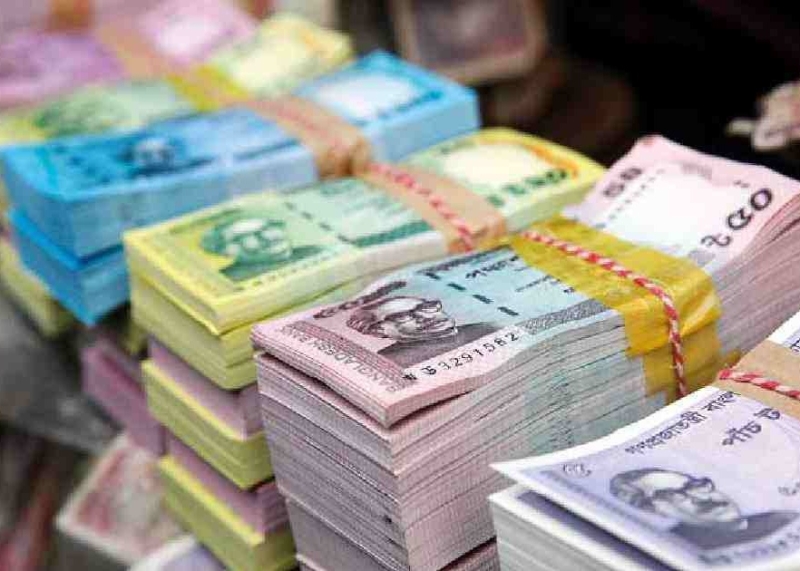- US Issues Travel Alert for Bangladesh Ahead of Election |
- Air ambulance carrying bullet-hit Hadi flies for Singapore |
- Can Dhaka’s arms recovery drive ensure peaceful polls? |
- ‘Unhealthy’ air quality recorded in Dhaka Monday morning |
- BD peacekeepers' deaths: UN chief calls Dr. Yunus, offers condolence |
Rising interest payments reflect growing dependence on foreign loans

Money in Bangladesh Taka.
Dhaka, Jan 14 - The government will have to pay some Tk 2915 billion (Tk 29,150 crore) in the next two fiscals for Interest payments, as it looks to service the debt it has built up over the years under a neoliberal paradigm.BWP.
Of the total, Tk 1370 billion (13,700 crore) will be needed for 2025-26 fiscal while Tk 1545 (15,450 crore) billion for 2026-27 fiscal, according to an official document of the Finance Ministry.
In 2025-26, Tk 1140 billion will be needed to pay domestic interest while Tk 230 billion for external interest rate.
For 2026-27 fiscal, the projection is Tk 1285 billion for domestic interest payment and Tk 260 billion for external interest payment.
In the running 2024-25 fiscal, the estimation of the interest payment is Tk 1130 billion. Of the amount, Tk 930 billion will be required for domestic purpose while Tk 200 billion for external.
Overall, the Interest payments projection illustrates a rising tendency in the government's interest expenditure over the years.
Interest payments were Tk 777.7 billion in FY22, of which Tk 732 billion was for domestic interest payment while Tk 45.6 billion for external interest payment.
As a proportion of the total budget, interest payments exhibit some fluctuation, starting at 15.3 percent in FY22, decreasing to 13.5 percent in FY24, and gradually rising again to 15.3 percent in FY27.
Domestic interest payments form the majority of total interest expenditure, projected to rise from Tk 732.18 billion in FY22 to Tk 1,285 billion in FY27.
The share of domestic interest payments in the total budget is estimated to decrease initially, from 14.1 percent in FY22 to 11.7 percent in FY25, before increasing back to 12.7 percent in FY27.
External interest payments, although a smaller portion of the total, are projected to increase significantly from Tk 45.6 billion in FY22 to Tk 260 billion in FY27.
The proportion of external interest payments in the total budget is also expected to rise from 0.9 percent in FY22 to 2.6 percent in FY27, reflecting an increasing impact of external debt on the budget.
Although roughly 40 percent of the deficit financing came from external sources in recent years, interest expenditure on domestic loans has been significantly higher than the interest expenditure on foreign loans.
This is due to the fact that most of the external loans that Bangladesh received from its developed partners are in concessional terms, while most of the domestic loans have been borrowed at market rates.
However, because of the tight monetary policy adopted by the advanced countries since 2022, interest expenditure on foreign loans is gradually increasing.
Interest expenditure on foreign loans are expected to remain above 2 percent in total expenditure in the medium-term primarily for two reasons- (1) reference rates in advanced countries are expected to remain elevated in the near future and (2) graduation from group of LDCs will gradually shrink the window for Bangladesh to get concessional loans from external sources.
The overall implicit interest rate on financing remains relatively stable throughout the period, ranging between 6 percent and 6.8 percent.
This indicates that the government's overall cost of borrowing is well-managed and remains within a predictable range.
The implicit interest rate on domestic borrowing shows a period of higher rates in FY24 and FY25, reaching 9.1 percent in FY24 and peaking at 9.6 percent in FY25.
This spike is primarily due to high inflation and tight monetary policy during these years. However, inflation is expected to ease in the medium term, leading to a potential reduction in both the central bank policy rate and domestic interest rates.
Consequently, the implicit interest rate on domestic borrowing is projected to decline to 9.4 percent in FY26 and further to 8.2 percent in FY27.
The implicit interest rate on external borrowing exhibits a gradual increase over the period, starting from 1 percent in FY21 and rising to 2.6 percent in FY27.
This increase is attributed to a higher proportion of borrowing through floating and semi-concessional rates, which are more sensitive to market fluctuations compared to fixed-rate financing. - UNB

